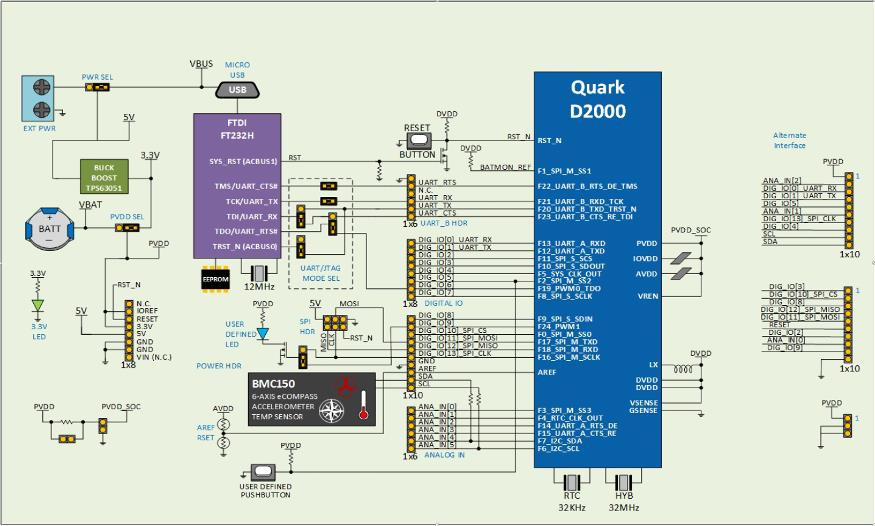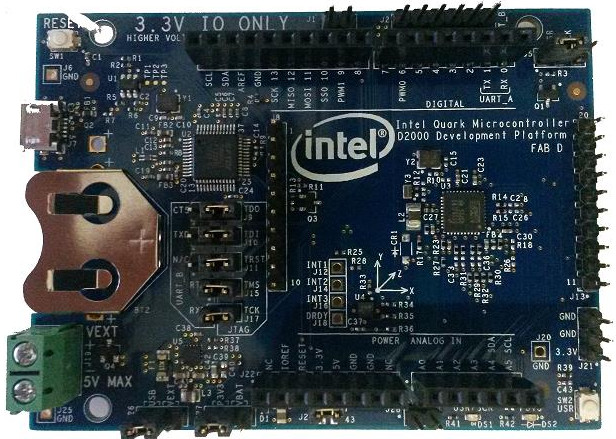Intel introduces three new Quark Micro-controllers last year, and I already experimented with Intel System Studio tools, quite similar to the Arduino IDE, and designed for hardware such as Intel Quark D1000 Customer Reference Board. So far the company had not released any boards available to the general public, but this has now changed since they’ve launched the “Intel Quark Microcontroller Developer Kit D2000”.
Intel Quark D2000 development board specifications:
- MCU – Intel Quark D2000 32-bit processor Intel Pentium x86-compatible without x87 FPU @ 32 MHz with 8 KB SRAM, 32 KB instruction flash, 8 KB OTP flash and 4 KB OTP data flash
- USB – 1x micro USB (JTAG) for power and programming/debugging
- Sensors – 6-axis Accelerometer / magnetometer with temperature sensor (Bosch Sensortec BCM150)
- Expansion options:
- Arduino Uno compatible SIL sockets (3.3V IO only)
- Booster pack compatible SIL headers (3.3V IO only)
- Misc – Reset and user buttons, jumpers, RTC
- Power Supply
- External (2.5V – 5V) DC input via screw terminal
- USB power (5V) via debug port
- Coin cell battery (type CR2032 not supplied)
- Dimensions – 8.4 x 5.7 cm

The board can also be developed with Intel System Studio for Microcontrollers IDE with support for GCC 5.2.1, Intel-enhanced GDB 7.9, Integrated Performance Primitives for Microcontrollers 1.0, Floating Point Emulation library, sample applications, a BSP for the Intel Quark Microcontroller Software Interface (Intel QMSI)
OpenOCD 0.8.0, TinyCrypt 0.1.0, Python 2.7.10, and more. The IDE works in Linux 64-bit (Ubuntu 14.04 LTS, and Fedora 21), and Windows 7/8.1/10 64-bit. All manufacturing and hardware design files have been released (Cadence Allegro), and documentation includes hardware and user’s guides.
The board can be purchased for $14.95 on Mouser, and you can visit Intel Quark Microcontroller D2000 product page for more details about the MCU and the development board, including all documentation.

Jean-Luc started CNX Software in 2010 as a part-time endeavor, before quitting his job as a software engineering manager, and starting to write daily news, and reviews full time later in 2011.
Support CNX Software! Donate via cryptocurrencies, become a Patron on Patreon, or purchase goods on Amazon or Aliexpress






Low energy is great but < 40K of flash and a CIS? How would you even fit a floating point emulation library? Which is largely useless when you have so little ram. You would be better doing any FP pretty much by hand, in fact, probably time to break out my 386 assembler from 20 years ago.
What I find so fascinating is that these exist at all. Maybe if you want a lot of IO and your developers are over 50? (As I am 🙂
I am near 50. 🙂
My first own built 386EX board could run the Data-light ROMDOS 6.0 in year 1995.
It had 256KB SRAM and 256KB ROM. The CPU clock was 25Mhz or 33Mhz probably.
If this new D2000 has 128KB of RAM and 128KB of Flash, I might try to port the mini BIOS and ROMDOS.
It will run Turbo-C or Borland-C generated executables perhaps.
But 8KB/32KB is too small for my old-school project.
I gave up. 🙁
These compete with an AVR32 or older ARM9. They are not competitive with the current ARM Cortex-Ax class CPUs. No FPU and no cache just kills them.
I would love it if Intel made a price competitive entry against the Allwinner A64. But the Intel solutions to compete with the A64 cost over $40 vs $5 for the A64. There have been rumors of decent cheap solutions from Intel, but they are only for “special” customers and normal people will never get access.
@Jon Smirl
Apart from micro-controllers for IoT, I don’t think Intel is interested in competing in the low cost segment as they just canceled plans for new low cost part -> http://www.cnx-software.com/2016/04/30/intel-cancels-low-cost-atom-broxton-sofia-socs/
@Jean-Luc Aufranc (CNXSoft)
Long term ignoring this market is bad for Intel. Desktop and laptop PCs are on a long term downward curve. Servers are under attack from ARM64. Those are Intel’s two main profit centers. Intel is rotting from the inside just like Microsoft. It is amazing that Intel is unable to make a competitive processor for a cell phone.
@Jon Smirl Desktops and laptops will never disappear. Intel and Co just need restrain their appetites. “Servers are under arm64 attack” – xD come on! This is true only at the anecdotal level. Have you forgotten there are ppc, sparc and even intel’s own Itanium – all so server-ish and mainframe-ish and they do exist a long time. But it looks like their “attack” had no effect on x86. In fact, opposite way, x86 has thrown them all off the server range into a deep niche and nearly non-existent state. And you are talking about arm64 which struggles to hold… Read more »